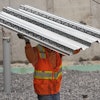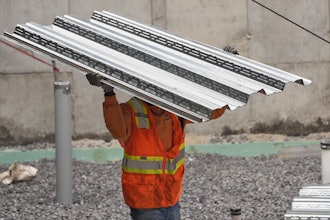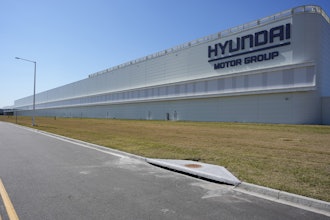Allen Chasey, Marketing Manager, Dynapar Corp
In today’s world of high-tech automation, the design engineer must consider a myriad of variables when specifying the right encoder. Incremental vs absolute output, resolution, and of course physical form factor are key parameters that most every engineer recognizes as top design elements. However, selection of the output chip or “driver” is just as important in many applications. At best, an improperly selected encoder output for the intended application can provide unreliable performance in the form of nuisance-trips, reduced throughput, or diminished production efficiency.
A Variety of Choices
As if the selection of manufacturer weren’t enough, many encoders offered in today’s marketplace are highly configurable. Resolution, shaft size, seal options, and connector variations all confront the design engineer with serious choices. Output type is equally important. In this paper, we’ll cover some of the more typical applications and common output types.
Application Considerations
Two of the biggest application considerations when selecting the proper encoder output are noise and cable length, which in many cases are interrelated. Longer cable runs by nature are more susceptible to noise as they become larger antennas and pick up noise. In cases like this, the type of cable used is paramount to a properly functioning system. Shielded, twisted-pair cable is a must, preferably of the low-capacitance variety. A good quality cable will have a low capacitance-per-foot rating, helping to ensure that the square-wave pulse leaving the encoder doesn’t become “saw-toothed” after traveling the distance to the controller end.
Another consideration is current drain. High-current line drivers can quickly become a liability in battery-powered applications where battery life is critical. However, many battery-powered systems are designed to be portable, so in many cases cable runs are in terms of inches rather than feet, so a high-current line driver may not be required. Of course, all of these considerations are a moot point if the controls being used won’t accept the encoder output chosen. If a motor drive is set up with differential line receivers, then it doesn’t make much sense to select an encoder with open collector outputs, even if the cable run is only a few feet.
Open Collector
One of the most prevalent and simplest kinds of output for incremental encoders is the open collector output (see Figure 1, below). As the name implies, the collector of the output transistor (internal to the encoder) is floating “open” so a pull-up resistor must be used to pull the signal to the supply voltage. The active output then pulls the signal down to switch the output pulses on and off, creating the familiar square wave. Many manufacturers will offer customers the choice of providing their own pull-up resistor, or will include it internally with the encoder.
The main advantage to the open collector is its simplicity and therefore inherent low cost. The open collector output is a current-sinking only device (sinks current from the load), and therefore suitable for shorter cable runs, typically below 30 ft in length. Since the open collector output cannot source or “push” current, it is unsuitable for longer cable runs or high-noise environments. As a result, the open-collector output is not suitable for use with differential or complementary encoder signals (A, A-not, B, B-not). However, if short cable runs and a low-noise environment are application characteristics, the open-collector output is probably the more economical choice.
Line Drivers
As the name implies, this kind of output chip sources or “drives” current down the line. Unlike the open collector outputs, line driver chips actively force the output high or low, therefore being able to both sink and source current from the load (see Figure 2, below). The main advantage of the line driver is its ability to push higher current through the cable, enabling longer cable runs. Although a line driver can be used in a single-ended format (i.e. push-pull output), they are most commonly used with complementary or differential signals. The use of the differential signal, when used with shielded, twisted-pair cabling, is paramount when using longer cable runs or in high-noise environments.
The 7272: Probably one of the most widely recognized line drivers is the 7272. This chip is offered in many competitive encoders and for good reason; the 7272 reaches a good compromise between current capability, usable voltage range, and chip cost. Typical current output capability of 7272 chips is in the 40-50 mA range, which is suitable for cable runs in the neighborhood of 50-75 ft. In addition, the 7272 chip typically offers the availability of a “mirrored voltage” output; in other words, whatever voltage is input to the encoder, that same voltage will be output (minus a small amount to account for encoder power requirements).
Another notable feature of the 7272 is its temperature-protective function. If the 7272 is being driven at its limits (high load, upper voltage limit, high frequency) thereby increasing temperature, it will go into a protective mode where it starts “dropping out” or stopping output. If allowed to cool, the chip will reset, much like a thermal switch, and begin functioning again. However, too many resets will cause the threshold level or trip point to lower over time, ultimately making the encoder unreliable. In short, if an application continues to cause these trip-outs, a different line driver should be selected.
The 4469: Another very prominent output choice is the 4469 line driver. Unlike the 7272, the 4469 has much higher current-driving capability, typically in the 100 mA range depending upon manufacturer. This is a definite advantage in applications with longer cable runs, usually between 100-300 ft. However, this higher current capability does come with a drawback. The 4469 can only dissipate so much power, so with this high current the voltage range is affected. A typical mirrored-voltage output is limited to 15 Vdc, but input voltage can be increased to 24 volts if a regulated 5 V output is chosen. As far as cost is concerned, the 4469 is comparable to the 7272. In addition, the 4469 does not have the automatic protective function — it can be driven as hard as possible without worry of a trip-out, but this can have an obvious adverse effect on its usable life.
The ic-DL: A newer choice in encoder output, the ic-DL type offers the best of both worlds — wide voltage range and high-current capability. A true “universal voltage” of 5-30 Vdc can be applied with the ic-DL chip, but this comes at a price — the typical component cost of this kind of chip can be up to five times that of the 7272 or 4469. One other unique feature of the ic-DL is its adaptive circuitry. This line driver will adapt its output impedance to match load requirements and the type of cable being used. This helps ensure a clean, crisp signal back at the controller regardless of the type of cable, length, and control device. Like the 7272, the ic-DL also features a protective function against over-temperature.
The Bottom Line
In summary, the application at hand should be the guide to selecting the right output. Although component cost is a consideration, reliable performance in the application is paramount to a successful design. The cost difference between output types almost becomes irrelevant when comparing a trouble-free application to a troublesome one. Compatibility with control electronics cannot be ignored either — if the control electronics can’t “shake hands” with the encoder, there’s no point in introducing them in the first place.
If you are still uncertain of the proper selection of encoder outputs, we highly recommend that you contact a reputable encoder manufacturer for guidance.





















